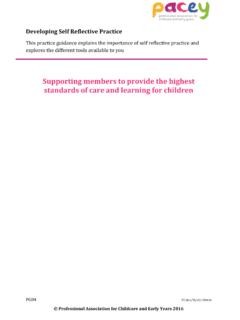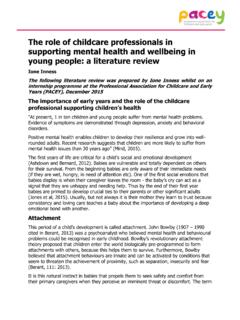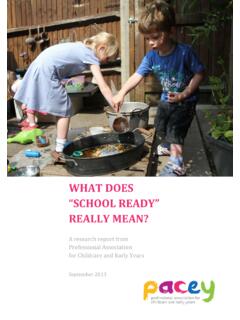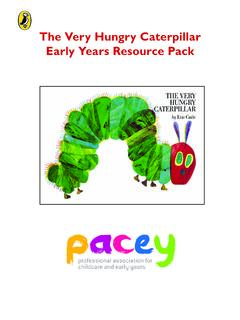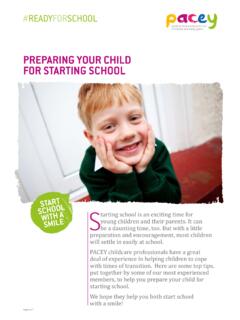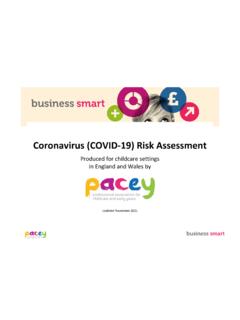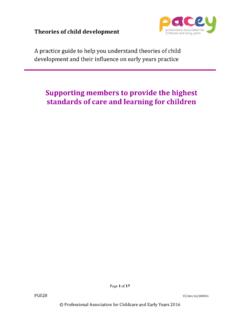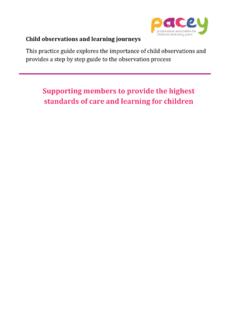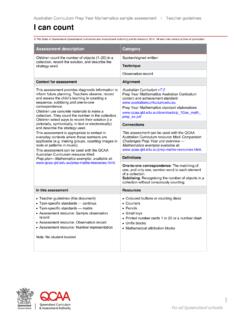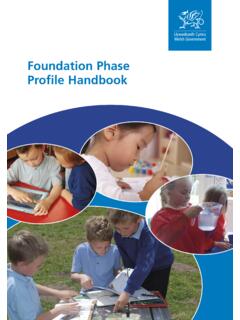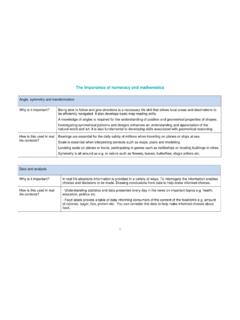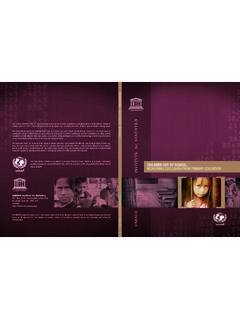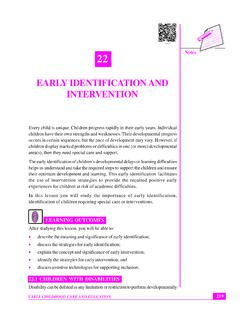Transcription of Supporting members to provide the highest standards of ...
1 PG 01 ST/development/TJ/v2/260914 Professional Association for Childcare and Early Years 2014 EYFS Prime and Specific Areas of Learning This practice guidance will consider areas of best practice when delivering the prime and specific areas of learning Supporting members to provide the highest standards of care and learning for children PG 01 ST/development/TJ/v2/260914 Professional Association for Childcare and Early Years 2014 This practice guidance has been developed for all professionals including childminders, nursery workers and nannies. This guide covers: 1. Section 1 (Learning and Development) 2. The three prime areas of learning and development 3. The four specific areas of learning and development 4. Summary 5. PACEY Professional standards 6.
2 References 7. Support from PACEY 1. Section 1 (Learning and Development) This practice guidance has been developed for childminders and nursery workers who work within the EYFS framework. Section 1 (Learning and Development) of the Early Years Foundation Stage (2014) describes what you must do to promote children s learning through the seven areas of learning and development. There is also non statutory guidance. Early Years outcomes- a guide for practitioners and inspectors to help inform understanding of child development through the early years and Development Matters, which details the characteristics of effective learning and offers suggestions as to how you can support children s learning through meaningful interaction and provision of appropriate resources within the environment.
3 There are 17 early learning goals. Development Matters also states how learning and development must be implemented through planned, purposeful play and that vital mix of adult led and child initiated play. All childcare settings on the Early Years register must deliver the areas of learning and development unless they have applied for an exemption to certain areas. For example, some Steiner settings have done this to fit in with their ethos of how children learn. The seven areas of learning and development are split into three prime and four specific areas. Research shows that the prime areas are time sensitive, if a child has not achieved the goals in these areas by the time they are 5-years-old, we know that they are much harder to achieve later in life. Development in the specific areas is underpinned by those in the prime areas.
4 Professionals working with the youngest children will focus on the prime areas although not exclusively as none of the areas are developed in isolation. For example everyday activities such as singing with babies or setting the table with toddlers can aid learning in literacy or mathematics. However focusing on the prime areas enables early identification of any concerns around development such as speech and language ensuring that support can be sought lessening the risk of children falling behind developmentally. 2. The three Prime Areas of Learning and Development The three prime areas of learning and development are: Communication and Language Physical Development Personal, Social and Emotional These lay down the foundation for all children s learning, ensuring that children are able to relate to others, communicate effectively and engage with their environment.
5 The prime areas are dependent on each other and are universal in that they occur within cultures and social backgrounds. The EYFS requires you to be mindful of children whose home language is not English; be vigilant in the provision of opportunities for children to develop and use their home language as well as gaining PG 01 ST/development/TJ/v2/260914 Professional Association for Childcare and Early Years 2014 opportunities to develop a good standard in English. In order to facilitate this, you will need to work in true partnership with children s families. Communication and Language The three aspects are: Listening and Attention Understanding Speaking From birth babies interact with those around them, they are dependent on their ability to communicate their needs effectively.
6 The aspects above are underpinned by the research of the Every Child a Talker (ECAT) programme, which showed that whilst childcare professionals were encouraging children to communicate there was a gap in Supporting the development of listening skills and building of attention skills. Let s consider some ways that you can support children s communication and language development Ensure a range of stories and rhymes and help children understand words by the use of actions. Talk with and listen to children allowing them time to decide what they want to say Encourage them to express their feelings, extend their vocabulary and support them to engage in symbolic play for example by providing dressing up and role play. Recognise and support children s home language by working in partnership with parents and invite them to contribute.
7 Remember the role of the key person in ensuring that they are aware of any specific words or non verbal communications that children use for particular items or needs, for example: How do they communicate that they need the toilet? What do they call their comforter? Display pictures and photographs and talk about them with children. PG 01 ST/development/TJ/v2/260914 Professional Association for Childcare and Early Years 2014 Physical Development The two aspects are: Moving and Handling Health and Self Care Children engage with their environment through physical interactions and movement, young children learn and explore through the use of all of their senses. They begin to make sense of their discoveries through experimenting and repeating movements.
8 Let s consider some ways that you can support children s physical development provide children with opportunities to be active, to develop their fine and gross motor skills and co-ordination. Babies and children need opportunities to move around freely both indoors and out, include experiences of negotiating space which develops an awareness of what their body is capable of and spatial awareness. provide tunnels, push along toys and trikes. provide opportunities to develop fine motor skills by safely using tools and equipment such as paint brushes, play-dough cutters and scissors. The aspect of Health and Self-care is part of physical development because children learn about how their bodies work by engaging in physical play. Encourage children to learn about how to be healthy through the provision of healthy meals and snacks and access to fresh drinking water.
9 Establish routines that enable children to look after themselves for example using coat hooks, washing their hands and putting on their shoes. Personal Social and Emotional The three aspects are: Making Relationships Self confidence and self awareness Managing feelings and behaviour In her 2011 report, Dame Claire Tickell recognised that Personal, Social and Emotional Development is one of the main building blocks for children s future success in life, this is also a reflection of the National Strategies research programme Social and Emotional Aspects of Development (SEAD). Research also demonstrates the importance of babies making early secure attachments with adults who are response and sensitive to their emotional and physical needs and the impact this has on their development.
10 This is where the role of an effective key person is vital in recognising children s individual needs and uniqueness, how children develop social skills in their interaction with others, and PG 01 ST/development/TJ/v2/260914 Professional Association for Childcare and Early Years 2014 develop a positive sense of themselves. This in turn enables children to manage their feelings and behaviour. Let s consider some ways that you can support children s personal, social and emotional development Ensure a range of stories and rhymes and help children understand words by explaining their use. Ensure you consider your role as a key person to support children to feel safe and secure. Think about how you meet and greet children and say goodbye to develop trust particularly with very young children.

